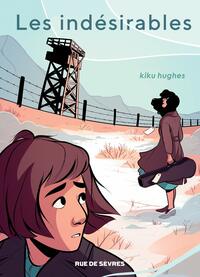Take a photo of a barcode or cover
In this graphic novel, Kiku is transported back in time to the same internment camp her grandmother’s family was imprisoned in during WWII, and she quickly realizes how little she knows about her own family’s painful history. Extremely important book, much needed today more than ever. Ages 12 and up.
challenging
emotional
hopeful
informative
inspiring
mysterious
fast-paced
Learning history in this way is just amazing. This book has the perfect amount of history lessons and real-world issues. This book is about the displaced Japanese-Americans during World War II, an overlooked part of the war is just special. Our main character being from the future and not knowing much about the topic but then being brought back to life through this horror is the best way to truly understand the topic. But then being brought back to the real world and correct time period and understanding why it is overlooked and also wanting to teach more people. It was just an amazing read and perfect for people who love history or want to know more.
Time travel / time slip narrative + teen learning about her family's history + little-told historical backdrop.
Quick read and so important.
Quick read and so important.
Displacement is one of the best books about WW2 and generational trauma for teens - making topics like racism, war, politics, and trauma accessible and easier to understand.
Read our full review on The Uncorked Librarian here: https://www.theuncorkedlibrarian.com/holocaust-books-high-school-middle-school/
*Please note that this reading list was recently updated to include Holocaust and all-encompassing YA WW2 books.
Read our full review on The Uncorked Librarian here: https://www.theuncorkedlibrarian.com/holocaust-books-high-school-middle-school/
*Please note that this reading list was recently updated to include Holocaust and all-encompassing YA WW2 books.
Kindred for kids! It's an excellent use of Butler's time travel trope in Kindred that is used here to lead the author to experience the Japanese internemtn near her grandmother. The past is show in blue, brown, and orange tones, while the present is is full color. In the present while her mother and Kiku walk around San Francisco trying to find where her grandmother lived before World War 2, Kiku is taken to a recital before the war and watches her grandmother play the violin. When they go back home to Seattle and Kiku's mother watched Trump speak at the Republican National Convention, teen Kiku is sent to the past and lives during the move to internment and staying in the camp for months. The past is will realized, but the characters are pretty thin. I love the idea of travelling to the past as ancestral memory. The experiences in the past led Kiku to learn more about her grandmother and her death before 50 may have been because she was in a camp because of dust and possible radiation. Thsi book makes the past feel real for kids, but it's focus is really on Kiku and the women in her family.
With a nod to Octavia Butler's Kindred, this brings an immediacy to the Japanese American Internment and its reverberations in the present
DISPLACEMENT is Kiku Hughes’ introspective and wonderfully illustrated graphic novel that blends fact and fiction. Kiku imagines herself as a teenager that suddenly sees a fog that transports her to another time. Through these “displacements” Kiku learns about her grandmother Ernestina’s time in the Japanese internment camp at the Topaz War Relocation Center during WWII.
My biggest takeaway from Displacement is the connection between generational trauma and identity. As a biracial teen, Kiku struggles to connect to her Japanese heritage and knows little about her family’s history. The shame from Ernestina’s experience as a detainee is passed on from grandmother to mother to daughter. Most Issei and Nisei avoided talking about their time at the concentration camps with their children. Banned from speaking Japanese at the camps and efforts to “Americanize” Japanese Americans resulted in the loss of language and connection to Japanese culture. Realizing this connection I took a pause and thought about my family and what we’ve lost from assimilation being silent about our history. This quote from DISPLACEMENT states this beautifully,
"Our connection to the past is not lost, even if we don't have all the documents, even if we never learn the details. The memories of community experiences stay with us and continue to affect our lives. . . Memories are powerful things."
These lasting impacts of the camps reveal the power of history and memory. Just because it’s not spoken doesn’t mean it’s not felt.
Also, Displacement is timely with its parallels to today’s anti-immigration sentiments: Trump, ICE and detention centers at the US-Mexico border and the Muslim ban. Hughes urges readers to not only remember and talk about the past, but bring it to the present and act, fight for justice and not be contributors to a community’s trauma.
Plus, I loved Displacement’s soothing color palette of greens/blues and oranges/browns. I borrowed the graphic novel as an e-book from my library. On a tablet, the illustrations are crisp. I’m curious to see the book in-person to compare how the colors come off the paper pages.
Compared to Farewell to Manzanar and They Called Us Enemy, other books about Japanese incarceration aimed towards young readers, Displacement offers a more modern lens and is a fantastic addition amongst these important works. This period in U.S. history serves as a reminder of the harrowing effects of racist policies on society and through generations.
My biggest takeaway from Displacement is the connection between generational trauma and identity. As a biracial teen, Kiku struggles to connect to her Japanese heritage and knows little about her family’s history. The shame from Ernestina’s experience as a detainee is passed on from grandmother to mother to daughter. Most Issei and Nisei avoided talking about their time at the concentration camps with their children. Banned from speaking Japanese at the camps and efforts to “Americanize” Japanese Americans resulted in the loss of language and connection to Japanese culture. Realizing this connection I took a pause and thought about my family and what we’ve lost from assimilation being silent about our history. This quote from DISPLACEMENT states this beautifully,
"Our connection to the past is not lost, even if we don't have all the documents, even if we never learn the details. The memories of community experiences stay with us and continue to affect our lives. . . Memories are powerful things."
These lasting impacts of the camps reveal the power of history and memory. Just because it’s not spoken doesn’t mean it’s not felt.
Also, Displacement is timely with its parallels to today’s anti-immigration sentiments: Trump, ICE and detention centers at the US-Mexico border and the Muslim ban. Hughes urges readers to not only remember and talk about the past, but bring it to the present and act, fight for justice and not be contributors to a community’s trauma.
Plus, I loved Displacement’s soothing color palette of greens/blues and oranges/browns. I borrowed the graphic novel as an e-book from my library. On a tablet, the illustrations are crisp. I’m curious to see the book in-person to compare how the colors come off the paper pages.
Compared to Farewell to Manzanar and They Called Us Enemy, other books about Japanese incarceration aimed towards young readers, Displacement offers a more modern lens and is a fantastic addition amongst these important works. This period in U.S. history serves as a reminder of the harrowing effects of racist policies on society and through generations.






